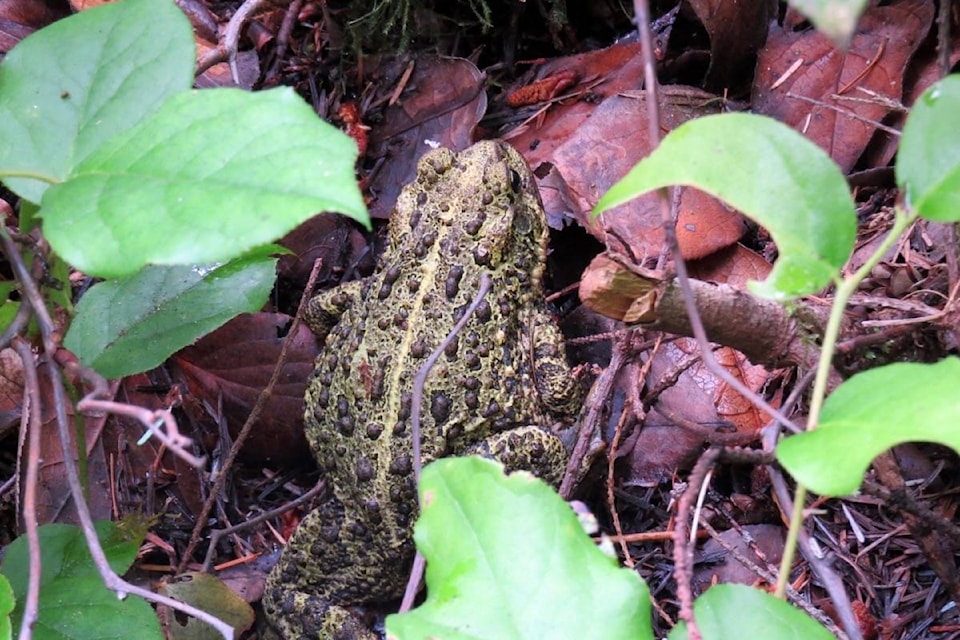For the past several weeks, I have been woken in the pre-dawn by the calls of a Western toad.
It seems to like the garden bed outside our bedroom window - strange as there is no water right there. The nearest water is a good 20 feet away so how could he be happy in one of hottest beds in my front garden?
Turns out, the Western toad - Anaxyrus Boreas, to give it its Latin name - utilizes three different habitats throughout the year.
There is its winter hibernation spot, its breeding ground, and its territorial summer area. They do prefer damp habitat, but are known to wander quite a distance from water, as is the case with our toad. While the bedroom garden bed does get watered, it is only done twice a week by hand.
Not what would be called a “damp habitat” by anyone’s interpretation, but perhaps the ground stays damper under my large Mexican mock orange shrub, Choisya x dewitteana Aztec Pearl. Toads do tend to spend most of their time underground, apparently, which would explain why I do not often see it. And it may explain how it is finding enough moisture to satisfy its needs.
Ever seen a Western toad? These are your typical “warty” toads with numerous dark bumps covering their back. Their colour can be pale green, grey, dark brown, or even reddish, but they all have a creamy yellow line running down the centre of their back from eyes to posterior. The eyes are gold-flecked with horizontal oval pupils and there are small, circular hearing structures (tympana) just behind each eye. Also very visible on their heads are the raised oblong shapes of the parotoid glands above the tympana.
Toads grow to almost six inches long - not counting their hind legs. They can live at least 10 years, according to reports. One toad kept in captivity (for study purposes, I presume) lived to 35 years of age.
I now know why I see so few insects in that garden bed. Western toads have quite a varied diet which includes ants, beetles, centipedes, earthworms (oh no!), slugs (yeah!), spiders, sowbugs; even larger critters and flying insects, if they can catch them. At the other end of the food scale, western toads are on the menu for garter snakes and some birds. However, the “warts” on their backs produce a bitter, white fluid when the toad feels threatened, making them an unpleasant snack for many predators.
Western toads are on the B.C. Provincial Yellow List, considered a species of conservation concern. Their numbers are declining, largely due to habitat destruction and climate change. Some researchers also feel the increased use of fertilizers is having an impact on toad populations. Certainly, frogs and toads have long been known to exhibit life-altering changes caused by unhealthy changes in their environment.
With this in mind, we are feeling quite blessed to have a Western toad residing right underneath our bedroom window. And truthfully, it, or one of its offspring, has been waking me up every summer for quite a number of years now.
On another note, our youngest daughter-in-law sent me a plea for help recently. Her dahlias were being plagued by earwigs and no non-chemical controls she had tried were working. If you are also having this pest problem in your dahlia patch, try scrunching some toilet paper, or newspaper into an empty toilet paper roll and placing the toilet paper roll right in the plant near the flowers. In the morning, remove the roll and gently ease the paper out of the roll over a pail of soapy water. This should help reduce the earwig population.
But FYI: earwigs are actually a beneficial insect in our gardens. They prey on aphids, slug eggs, and other soft-bodied larvae. So do try not to annihilate all of the earwigs in your garden.
Leslie Cox co-owns Growing Concern Cottage Garden in Black Creek. Her website is at www.duchessofdirt.ca
